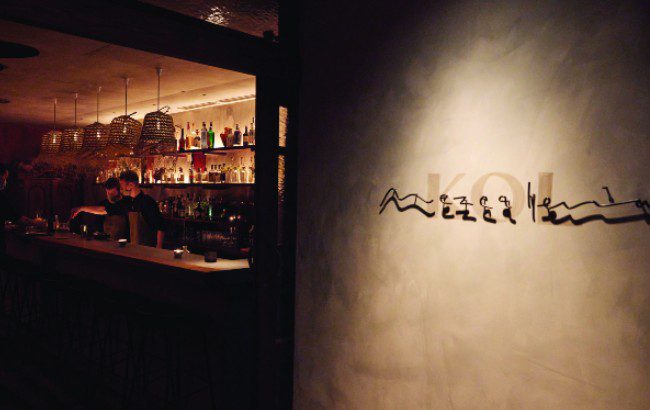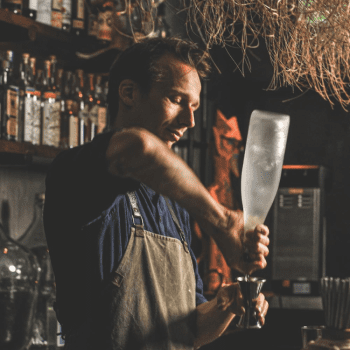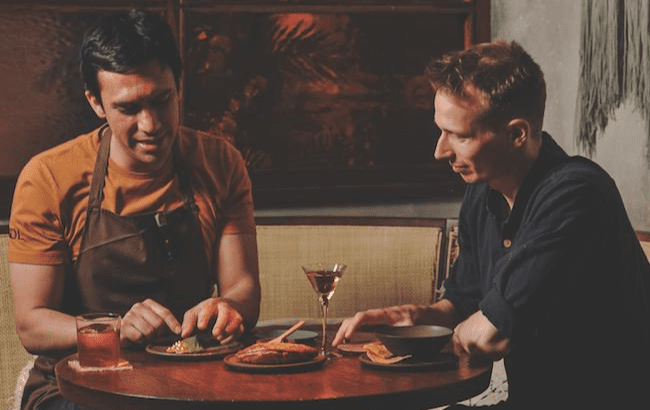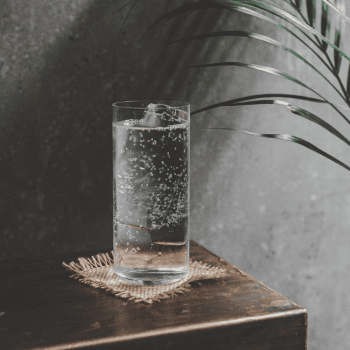Cocktail chat: Kol Mezcaleria
Kol Mezcaleria, downstairs from acclaimed London restaurant Kol, is both a part of yet separate from the main space. Bar manager Matthias Ingelmann tells us about the symbiosis of the two venues, their creativity and seasonality.

*This feature was first published in the December 2022 issue of The Spirits Business magazine.
The restaurant bar’s position in the drinks industry is often seen as a dubious one. For many, it’s the waiting room before the show, a place to pass time while anticipating the curtain rise on their table. But as innovation and collaboration continue to lead in hospitality, the restaurant bar is becoming an entity that can stand out of the shadow of the dining room, and in a spotlight of its own.

The Mezcaleria at Kol is such a bar. Found in the basement beneath the Michelin-starred Marylebone restaurant, which boasted an extensive reservation waiting list within weeks of opening in October 2020, Kol Mezcaleria opened in the spring of the following year under the management of Maxim Schulte, formerly of The American Bar at The Savoy, and head bartender Matthias Ingelmann, who inherited Schulte’s bar manager title when he left to pursue other avenues this year.
Common ground
While Kol and the The Mezcaleria share an entrance, they hold their own as two distinct spaces. They are siblings independent of each other, but with enough common ground to play nicely when the occasion calls. And according to German Ingelmann, that occasion calls regularly, thanks to the arm-in-arm approach of the food and drink offerings from the kitchen and the bar: “Upstairs in the restaurant we do a lot of pairings,” he tells me. “We, of course, do the traditional wine pairing, but we also do a mezcal pairing, as well as a drinks pairing – a mix of cocktails, agaves, wines, and beers, as well as nonalcoholics, like juices and kombuchas – almost like a best of the drinks.”
While drinks pairing isn’t a new concept, Kol and The Mezcaleria have taken a creative approach to how they bring the food and drink together. Once you’ve made it to the end of the three-month waiting list for a table at Kol, and spent some time in the bar before or after, it’s easy to see the synergy between the two. The flavours are unique, creative, lick-the-plate clean, and drain-the-glass delicious, but never overpowering or controversial. This is a conscious decision made by Ingelmann and Santiago Lastra, Kol’s chef patron.
“We design all the food and drinks so that they work well together,” Ingelmann explains. “The serves are usually quite light, not overpowering, and easy to drink, with nice balanced flavours. Santiago does it in a similar way in the kitchen – his cooking style in general isn’t about massively bold flavours that destroy everything else around it. He likes the delicate, light, refreshing, so the food goes well with the drinks. It is a harmonious amalgamation.”
Ingelmann explains the pairing process. “Balance is an important word in terms of how we approach drinks, food and the menu design. We start with an ingredient idea, and look at what is coming into season in the UK, and what we’ll be able to get. Then we plan how we can use this in drinks and dishes.”

Drinks offering
In Kol Mezcaleria, there isn’t a pairing offering as such, but the drinks menu is designed to complement the selection of antojitos, literally translated as ‘little cravings’, which are Lastra’s interpretation of traditional Mexican street food and delicacies from indigenous communities in the country.
Ingelmann says: “We like to look at what the kitchen are doing, and then for every dish we like to have at least two drinks that could go really well with it.”
In Mexico, it is said that there’s no drink without food, and few spirits lend themselves to traditional Mexican fare as well as the savoury notes of agave spirits, making mezcal the perfect partner for Lastra’s dishes. This offers the team an opportunity to showcase mezcal to a new audience.
“It happens a lot that the guests will not have had mezcal before, and they’re new to the category, so in a way they are there for an educational purpose. Often they come to the bar before dinner to try two or three mezcals as an introduction, then go upstairs and have the mezcal pairing, continuing the journey. We also get lots of guests that come down after dinner or lunch to continue their mezcal experience,” he says.
 I’m intrigued to learn how a venue that boasts approximately 100 mezcals on its backbar goes about choosing the bottles for each flight or pairing. “This is our opportunity to really highlight lots of different styles, agaves, production methods, and showcase the whole category,” Ingelmann tells me.
I’m intrigued to learn how a venue that boasts approximately 100 mezcals on its backbar goes about choosing the bottles for each flight or pairing. “This is our opportunity to really highlight lots of different styles, agaves, production methods, and showcase the whole category,” Ingelmann tells me.
“Usually we taste the food and work out a general flavour profile – so if we have a dish that is a bit lighter, I know a raicilla could go well, or with a main course that is bit bolder you could pair a tobalá, which has a really nice richness and a big body, but then it depends on how experienced the guest is.
“If we have someone who has never had mezcal before, then we adjust the pairing, so we can do a soft introduction and see what they like. But we can try crazy things with mezcal nerds.”
Among the extensive spirits collection, which spans agave spirits of all varieties, as well as Mexican spirits such as whisky from Oaxaca, rum from Puebla and gin from Yucatán, the bottle line-up also includes four house mezcals of Kol’s own, sourced in collaboration with independent spirits bottler and importer El Destilado.
“We have a rotating section of four mezcals in the Kol collection,” Ingelmann explains. “They are quite small batch, so we always try to keep a balance: one expression will be a bit more funky, one a bit different from what you might expect, one more fresh, and the final one more traditional. We have a nice balance throughout our range, so they always feature in our pairings.”
All of this is not to say that the drinks can’t be enjoyed without food. This is a bar, after all, and the menu is spectacular on its own.
Clever techniques
With a policy in the bar and kitchen that disallows the importation of ingredients other than corn, chilli or chocolate, the menu features various clever techniques and solutions.
How does one make a Margarita without importing citrus? A challenge the team answered with verjus – unfermented grape juice – which has resulted in a lively and refreshing pour, served with a generous dusting of a citric acid salt on the rim.
The rest of the creativity, as Ingelmann says, is down to working with seasonality, with the bar’s cocktail menu taking five seasonal ingredient duos and using them to create a two-cocktail demonstration of what this bar does best: pairings, and delivering flavour.
Related news
Cocktail stories: Speed Bump, Byrdi
